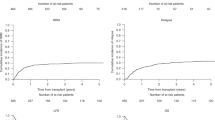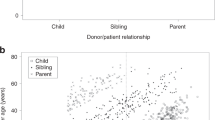Summary:
Hematological inherited diseases can be cured by hematopoietic stem cell transplantation (HSCT) from an human leukocyte antigen (HLA)-identical sibling donor (MSD), but the outcome of unrelated donors (URD) or haploidentical donors (HMD) has been a cause of concern. In all, 94 children affected with inherited diseases underwent HSCT at a single center using MSD (group A, n=31), URD (group B, n=23) or HMD (group C, n=40). There was no difference in the rate of engraftment or in the incidence of grades III–IV acute graft-versus-host disease (GVHD) between the groups. Survival rate was 80.6% in group A, 62.5% in group B and 47.5% in group C (P=0.023). In group B, survival rate was 73.7% in the subgroup with zero or one class I mismatch, and 25% in the subgroup with two or more class I mismatches (P=0.04). In group C, survival rate was 83.3% in the 9/10-identical subgroup, 64.3% in the seven or 8/10 subgroup, and 25% in the five or 6/10 subgroup (P=0.0007). Thus, engraftment, incidence of GVHD and survival are similar in recipients of grafts from MSD, URD with 0–1 class I-mismatch, or HMD with at least 7/10 HLA matches. The low success of HSCT using more disparate donors suggests reserving them for patients with very poor prognosis.
This is a preview of subscription content, access via your institution
Access options
Subscribe to this journal
Receive 12 print issues and online access
$259.00 per year
only $21.58 per issue
Buy this article
- Purchase on Springer Link
- Instant access to full article PDF
Prices may be subject to local taxes which are calculated during checkout

Similar content being viewed by others
References
Hansen JA, Petersdorf E, Martin PJ, Anasetti C . Hematopoietic stem cell transplants from unrelated donors. Immunol Rev 1997; 157: 141–151.
Fischer A, Landais P, Friedrich W et al. European experience of bone-marrow transplantation for severe combined immunodeficiency. Lancet 1990; 336: 850–854.
Beatty PG, Clift RA, Mickelson EM et al. Marrow transplantation from related donors other than HLA-identical siblings. N Engl J Med 1985; 313: 765–771.
Kernan NA, Bartsch G, Ash RC et al. Analysis of 462 transplantations from unrelated donors facilitated by the National Marrow Donor Program. N Engl J Med 1993; 328: 593–602.
Madrigal JA, Scott I, Arguello R et al. Factors influencing the outcome of bone marrow transplants using unrelated donors. Immunol Rev 1997; 157: 153–166.
Tiercy JM, Villard J, Roosnek E . Selection of unrelated bone marrow donors by serology, molecular typing and cellular assays. Transpl Immunol 2002; 10: 215–221.
Scott I, O'Shea J, Bunce M et al. Molecular typing shows a high level of HLA class I incompatibility in serologically well matched donor/patient pairs: implications for unrelated bone marrow donor selection. Blood 1998; 92: 4864–4871.
Speiser DE, Tiercy JM, Rufer N et al. High resolution HLA matching associated with decreased mortality after unrelated bone marrow transplantation. Blood 1996; 87: 4455–4462.
Hansen JA, Gooley TA, Martin PJ et al. Bone marrow transplants from unrelated donors for patients with chronic myeloid leukemia. N Engl J Med 1998; 338: 962–968.
Petersdorf EW, Longton GM, Anasetti C et al. The significance of HLA-DRB1 matching on clinical outcome after HLA-A, B, DR identical unrelated donor marrow transplantation. Blood 1995; 86: 1606–1613.
Devergie A, Apperley JF, Labopin M et al. European results of matched unrelated donor bone marrow transplantation for chronic myeloid leukemia. Impact of HLA class II matching. Chronic Leukemia Working Party of the European Group for Blood and Marrow Transplantation. Bone Marrow Transplant 1997; 20: 11–19.
Petersdorf EW, Hansen JA, Martin PJ et al. Major-histocompatibility-complex class I alleles and antigens in hematopoietic-cell transplantation. N Engl J Med. 2001; 345: 1794–1800.
Petersdorf EW, Gooley TA, Anasetti C et al. Optimizing outcome after unrelated marrow transplantation by comprehensive matching of HLA class I and II alleles in the donor and recipient. Blood 1998; 92: 3515–3520.
Sasazuki T, Juji T, Morishima Y et al. Effect of matching of class I HLA alleles on clinical outcome after transplantation of hematopoietic stem cells from an unrelated donor. Japan Marrow Donor Program. N Engl J Med. 1998; 339: 1177–1185.
Drobyski WR, Klein J, Flomenberg N et al. Superior survival associated with transplantation of matched unrelated versus one-antigen-mismatched unrelated or highly human leukocyte antigen-disparate haploidentical family donor marrow grafts for the treatment of hematologic malignancies: establishing a treatment algorithm for recipients of alternative donor grafts. Blood 2002; 99: 806–814.
Petersdorf EW, Anasetti C, Martin PJ, Hansen JA . Tissue typing in support of unrelated hematopoietic cell transplantation. Tissue Antigens 2003; 61: 1–11.
Casper J, Camitta B, Truitt R et al. Unrelated bone marrow donor transplants for children with leukemia or myelodysplasia. Blood 1995; 85: 2354–2363.
Oakhill A, Pamphilon DH, Potter MN et al. Unrelated donor bone marrow transplantation for children with relapsed acute lymphoblastic leukaemia in second complete remission. Br J Haematol 1996; 94: 574–578.
Woolfrey AE, Anasetti C, Storer B et al. Factors associated with outcome after unrelated marrow transplantation for treatment of acute lymphoblastic leukemia in children. Blood 2002; 99: 2002–2008.
Al-Kasim FA, Thornley I, Rolland M et al. Single-centre experience with allogeneic bone marrow transplantation for acute lymphoblastic leukaemia in childhood: similar survival after matched-related and matched-unrelated donor transplants. Br J Haematol 2002; 116: 483–490.
Veys PA, Meral A, Hassan A et al. Haploidentical related transplants and unrelated donor transplants with T cell addback. Bone Marrow Transplant. 1998; 21 (Suppl. 2): S42–S44.
Jabado N, Le Deist F, Cant A et al. Bone marrow transplantation from genetically HLA-nonidentical donors in children with fatal inherited disorders excluding severe combined immunodeficiencies: use of two monoclonal antibodies to prevent graft rejection. Pediatrics 1996; 98: 420–428.
Glucksberg H, Storb R, Fefer A et al. Clinical manifestations of graft-versus-host disease in human recipients of marrow from HL-A-matched sibling donors. Transplantation 1974; 18: 295–304.
Petersdorf EW, Smith AG, Mickelson EM et al. The role of HLA-DPB1 disparity in the development of acute graft-versus- host disease following unrelated donor marrow transplantation. Blood 1993; 81: 1923–1932.
Prasad VK, Heller G, Kernan NA et al. The probability of HLA-C matching between patient and unrelated donor at the molecular level: estimations based on the linkage disequilibrium between DNA typed HLA-B and HLA-C alleles. Transplantation 1999; 68: 1044–1050.
Hurley CK, Baxter-Lowe LA, Begovich AB et al. The extent of HLA class II allele level disparity in unrelated bone marrow transplantation: analysis of 1259 National Marrow Donor Program donor-recipient pairs. Bone Marrow Transplant 2000; 25: 385–393.
El Kassar N, Legouvello S, Joseph CM et al. High resolution HLA class I and II typing and CTLp frequency in unrelated donor transplantation: a single-institution retrospective study of 69 BMTs. Bone Marrow Transplant 2001; 27: 35–43.
Fleischhauer K, Kernan NA, O'Reilly RJ et al. Bone marrow-allograft rejection by T lymphocytes recognizing a single amino acid difference in HLA-B44. N Engl J Med 1990; 323: 1818–1822.
Ferrara GB, Bacigalupo A, Lamparelli T et al. Bone marrow transplantation from unrelated donors: the impact of mismatches with substitutions at position 116 of the human leukocyte antigen class I heavy chain. Blood 2001; 98: 3150–3155.
Guardiola P, Pasquini R, Dokal I et al. Outcome of 69 allogeneic stem cell transplantations for Fanconi anemia using HLA-matched unrelated donors: a study on behalf of the European Group for Blood and Marrow Transplantation. Blood 2000; 95: 422–429.
Antoine C, Muller S, Cant A et al. Long-term survival and transplantation of haemopoietic stem cells for immunodeficiencies: report of the European experience 1968–99. Lancet 2003; 361: 553–560.
Green A, Clarke E, Hunt L et al. Children with acute lymphoblastic leukemia who receive T-cell-depleted HLA mismatched marrow allografts from unrelated donors have an increased incidence of primary graft failure but a similar overall transplant outcome. Blood 1999; 94: 2236–2246.
Andre-Schmutz I, Le Deist F, Hacein-Bey-Abina S et al. Immune reconstitution without graft-versus-host disease after haemopoietic stem-cell transplantation: a phase 1/2 study. Lancet 2002; 360: 130–137.
Guinan EC, Boussiotis VA, Neuberg D et al. Transplantation of anergic histoincompatible bone marrow allografts. N Engl J Med 1999; 340: 1704–1714.
Acknowledgements
We are grateful to Colette Raffoux for critical reading of the manuscript. We thank Isabelle Hirsch for help in the collection of data, and Edith Audran, Patricia Przednowed and Christine Deshayes for excellent technical assistance.
This work was supported by Assitance Publique-Hôpitaux de Paris. We also thank France Greffe de Moelle for help in selection of donors, and Association Française des Myopathies for continuous support of the Laboratory of Cellular Therapy.
Author information
Authors and Affiliations
Corresponding author
Rights and permissions
About this article
Cite this article
Caillat-Zucman, S., Le Deist, F., Haddad, E. et al. Impact of HLA matching on outcome of hematopoietic stem cell transplantation in children with inherited diseases: a single-center comparative analysis of genoidentical, haploidentical or unrelated donors. Bone Marrow Transplant 33, 1089–1095 (2004). https://doi.org/10.1038/sj.bmt.1704510
Received:
Accepted:
Published:
Issue Date:
DOI: https://doi.org/10.1038/sj.bmt.1704510
Keywords
This article is cited by
-
Matched unrelated bone marrow transplant for Omenn syndrome
Immunologic Research (2009)
-
Matched unrelated bone marrow transplant for T+ combined immunodeficiency
Bone Marrow Transplantation (2008)
-
Principles and analysis of hematopoietic stem cell transplantation outcomes: the physician’s perspective
Lifetime Data Analysis (2008)
-
Matched unrelated bone marrow transplant for severe combined immunodeficiency
Immunologic Research (2007)
-
Pediatric Hemophagocytic Syndromes: A Diagnostic and Therapeutic Challenge
Allergy, Asthma & Clinical Immunology (2005)



